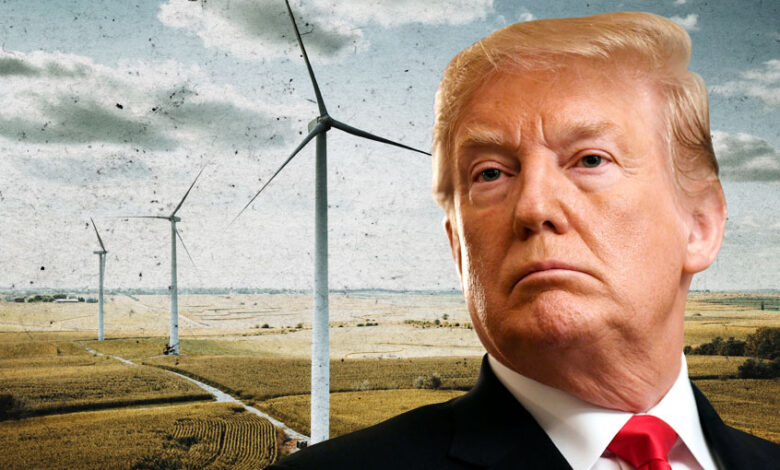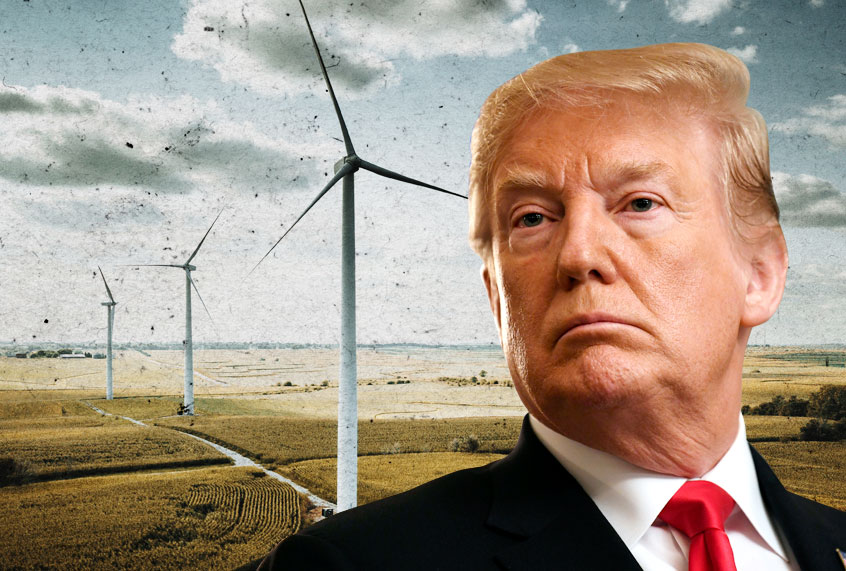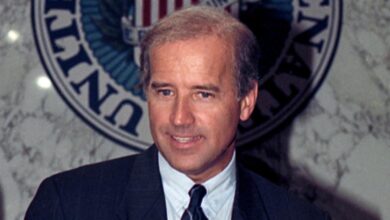
Trump Vows Offshore Wind Power Action on Day One
Trump promises action against offshore wind power projects on day one of presidency – Trump promised action against offshore wind power projects on day one of his presidency, sparking a wave of controversy and debate. His stance, driven by concerns about economic impact and environmental consequences, targeted specific projects and ignited a broader discussion about the future of renewable energy in the United States.
This promise, however, was not made in a vacuum. It emerged from a complex political landscape where industry stakeholders, environmental groups, and local communities all played a role in shaping the discourse.
Trump’s actions, including executive orders and regulatory changes, aimed to hinder offshore wind development, creating significant challenges for the industry and raising questions about the long-term consequences of his policies. This move, however, also ignited a public debate, with proponents and opponents engaging in heated discussions about the potential benefits and drawbacks of offshore wind power.
Trump’s Stance on Offshore Wind Power
During his presidency, Donald Trump consistently expressed opposition to offshore wind power projects, citing a range of concerns about their environmental impact, economic feasibility, and potential visual intrusion. His stance was characterized by a strong preference for traditional energy sources, particularly fossil fuels.
Trump’s Stated Reasons for Opposition
Trump’s opposition to offshore wind power was rooted in his belief that these projects would harm the environment, particularly marine life and coastal ecosystems. He also questioned their economic viability, arguing that they were too expensive and would not create enough jobs.
Additionally, he voiced concerns about the visual impact of wind turbines on coastal landscapes.
Specific Projects Targeted
Trump’s administration actively sought to hinder the development of several offshore wind projects, including the Vineyard Wind project off the coast of Massachusetts. This project, a joint venture between Avangrid Renewables and Copenhagen Infrastructure Partners, faced significant delays and regulatory hurdles under the Trump administration.
Trump’s administration argued that the project posed a threat to endangered North Atlantic right whales, despite scientific assessments that concluded otherwise. Similar concerns were raised regarding the proposed Coastal Virginia Offshore Wind project, which aimed to develop a wind farm off the coast of Virginia.
Economic and Environmental Implications of Trump’s Stance
Trump’s opposition to offshore wind power had significant economic and environmental implications. By delaying or blocking projects, his administration hindered the growth of a burgeoning industry that had the potential to create thousands of jobs and contribute to the transition to a cleaner energy future.
Trump’s promise to take action against offshore wind power projects on day one of his presidency highlights a stark contrast in priorities between him and his opponents. While he focused on energy independence and traditional energy sources, others see the potential of renewable energy.
It’s interesting to see how this same contrast plays out in other political battles, like the one in Georgia, where abortion rights are a key issue. Read more about how abortion is already animating the senate race in Georgia here.
These kinds of polarizing issues are shaping the political landscape, and it’s clear that the fight over offshore wind power is just one battle in a larger war over the future of our energy policies.
Furthermore, his stance undermined efforts to address climate change by promoting the continued reliance on fossil fuels.
The Context of Trump’s Promise: Trump Promises Action Against Offshore Wind Power Projects On Day One Of Presidency
Trump’s promise to halt offshore wind development on his first day in office was a reflection of the deeply polarized political landscape surrounding renewable energy during his presidency. This promise, while ultimately not fulfilled, highlighted the complex interplay of industry interests, environmental concerns, and local community anxieties that shaped the debate around offshore wind power.
Industry Stakeholders and Their Interests
Industry stakeholders, including fossil fuel companies and traditional energy producers, generally opposed the expansion of offshore wind energy. They argued that wind power was an unreliable and intermittent source of energy, posing risks to existing energy infrastructure and potentially jeopardizing the viability of traditional energy industries.
While Trump promised to roll back offshore wind projects on day one of his presidency, India is pushing forward with innovative technology. The country just opened the liquid mirror telescope , a groundbreaking design that uses a rotating pool of mercury to create a reflective surface.
This innovative approach to astronomy highlights the potential for alternative energy solutions, a stark contrast to Trump’s stance on offshore wind power.
They also raised concerns about the potential environmental impacts of wind turbine construction and operation, including noise pollution, habitat disruption, and impacts on bird and bat populations.
Environmental Groups and Their Perspectives, Trump promises action against offshore wind power projects on day one of presidency
Environmental groups, on the other hand, largely supported the development of offshore wind energy, citing its potential to reduce greenhouse gas emissions and combat climate change. They argued that the environmental impacts of wind energy were significantly less severe than those associated with fossil fuels, and that offshore wind farms could be sited and operated in ways that minimized ecological damage.
While the political landscape is abuzz with talk of Trump’s promises to tackle offshore wind power projects, it’s important to remember that education remains a crucial pillar of our society. Thankfully, companies like Savvas are stepping up to address the learning needs of our youth, offering new summer solutions for math and literacy to move learning forward here.
Whether or not Trump’s plans for offshore wind power projects come to fruition, investing in our children’s education is a commitment that should remain unwavering.
They also emphasized the economic benefits of wind energy, including job creation and investment in renewable energy infrastructure.
Local Communities and Their Concerns
Local communities often expressed mixed views on offshore wind projects, with some welcoming the economic benefits and environmental advantages, while others voiced concerns about potential impacts on tourism, fishing, and scenic views. Some coastal communities were concerned about the potential for wind turbines to disrupt their traditional livelihoods and negatively impact the local economy.
Broader Energy Policy Context
Trump’s stance on offshore wind power was part of a broader energy policy agenda that prioritized fossil fuels and sought to reduce the role of renewable energy sources. He rolled back environmental regulations, withdrew from the Paris Climate Agreement, and promoted the expansion of coal and natural gas production.
This approach was widely criticized by environmental groups and many scientists who argued that it would exacerbate climate change and undermine efforts to transition to a cleaner energy future.
Public Perception and Debate
Public opinion on offshore wind power during Trump’s presidency was a complex landscape shaped by a combination of factors, including political rhetoric, media coverage, and public concerns. While there was general support for renewable energy sources, offshore wind faced unique challenges and controversies.
Public Opinion Polls and Surveys
Public opinion polls conducted during Trump’s presidency revealed a mixed picture on offshore wind power. While many Americans supported renewable energy sources in general, there were concerns about the potential environmental impacts and aesthetic changes associated with offshore wind farms.
For example, a 2017 poll by the Pew Research Center found that 69% of Americans favored increasing the use of wind energy, but there were also concerns about the potential visual impact of wind turbines.
Arguments Presented by Proponents and Opponents
The debate surrounding offshore wind development was characterized by contrasting arguments from proponents and opponents.
Proponents
Proponents of offshore wind development often emphasized its potential benefits, including:
- Clean Energy Source: Offshore wind power is a renewable and emission-free source of energy, contributing to efforts to combat climate change.
- Economic Benefits: Offshore wind projects create jobs in construction, manufacturing, and operations, boosting local economies.
- Energy Security: Offshore wind reduces reliance on fossil fuels and enhances energy security by diversifying energy sources.
Opponents
Opponents of offshore wind development often raised concerns about:
- Environmental Impacts: Concerns about potential harm to marine life, bird populations, and the ecosystem.
- Visual Impact: Concerns about the visual impact of wind turbines on coastal landscapes and tourism.
- Cost: Concerns about the high cost of offshore wind development compared to other energy sources.
Role of Media Coverage
Media coverage played a significant role in shaping public perceptions of offshore wind power. While some media outlets highlighted the potential benefits of offshore wind, others focused on the concerns and controversies surrounding the technology. For example, some media outlets emphasized the potential environmental impacts of offshore wind farms, while others highlighted the economic benefits and job creation potential.
The way media outlets framed the issue influenced public opinion and the level of support for offshore wind development.
Last Word

Trump’s promise to take action against offshore wind power projects on day one of his presidency left a lasting impact on the industry and the broader energy landscape. His actions, driven by his stated concerns, sparked a contentious debate that continues to shape the future of renewable energy in the United States.
The legacy of his policies, however, remains a subject of ongoing discussion and analysis, with implications for both the immediate and long-term prospects of offshore wind power development.





